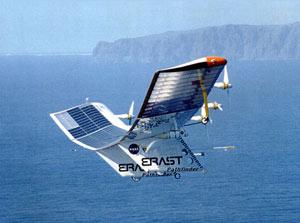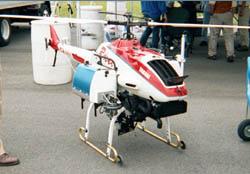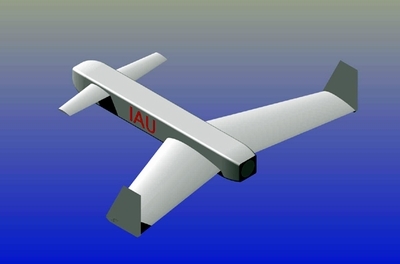Intentional Near Misses
 One of these planes is not like the other. Pilots
spent four days this week flying a trio of airplanes at each other
over the Mojave Desert, missing on each pass by as little as 1,000
feet.
One of these planes is not like the other. Pilots
spent four days this week flying a trio of airplanes at each other
over the Mojave Desert, missing on each pass by as little as 1,000
feet.
But one of the four pilots wasn't actually in the air.
Some 11,500 feet below the cockpit, the pilot sat safely on the
ground as he coolly scrambled to avoid hitting his colleagues with
the skeletal experimental aircraft he flew by remote control.
Say, Mr. Benny, If You're Down Here, Who's Flying The
Plane?
The remote-controlled drone aircraft Proteus is seen during
anews briefing at the Mojave, Calif., airport Thursday. Controlled
from the ground, the plane made test flights over the Mojave
Desert, with a pilot sitting in the cockpit but not touching the
controls. NASA is working on collision-avoidance systems that would
allow drones to operate freely in civil airspace but authorities
are concerned that they could pose a hazard to other aircraft.

The flights are part of a NASA project to develop a
collision-avoidance system that would allow fully autonomous, and
not just remotely piloted, aircraft to operate in civil
airspace.
The robotic drones, commonly called UAVs, have garnered lots of
publicity thanks to their high-profile, military roles in Kosovo,
Afghanistan, Yemen and, now, Iraq. Yet beyond the hype, the planes
still aren't approved for routine use over the United States.
The Federal Aviation Administration remains concerned the drones
could pose a collision hazard to other, piloted aircraft. For now,
the FAA must certify each drone flight, or series of flights,
individually.
Meeting Standards
 The FAA, Pentagon and NASA are studying the safety
and reliability standards that drones must meet, FAA spokesman
William Shumann said.
The FAA, Pentagon and NASA are studying the safety
and reliability standards that drones must meet, FAA spokesman
William Shumann said.
The FAA wants to make sure that drones can respond as quickly as
piloted aircraft to instructions from air traffic controllers,
Shumann said. It's also uncertain whether remote operators of
drones would need to be licensed pilots, he added.
During 20 collision scenarios flown in restricted airspace over
four days and completed on Friday, the ground-based pilots of the
experimental Proteus saw nothing of the other two planes, save the
stream of radar and other data that alerted them to their
presence.
Each time the Proteus maneuvered in time to avoid colliding with
the other aircraft — an F/A-18 jet and a propeller-driven
Beechcraft.
"We were seeing the targets earlier than the pilots in some
cases," said Peter Siebold, a test pilot for Proteus builder Scaled
Composites LLC. (A pilot and co-pilot were aboard the Proteus, but
only as backups.)
Engineers equipped the Proteus with a radar system originally
developed to help low-flying helicopter pilots avoid power lines.
The plane also carried an instrument able to detect the
transponders found in larger aircraft, though not gliders, hot air
balloons and antique planes.

Multi-Modal Collision Avoidance
Eventually, engineers envision a system that combines radar,
transponders, cameras and other instruments so drones can operate
as safely as any other plane. Such a system is anywhere from 10
years to 15 years away.
"The demonstrations we're doing are not the definitive answer.
They're a step on the way," said Glenn Hamilton, of the National
Aeronautics and Space Administration's Dryden Flight Research
Center.
Teal Group Corp. aviation analyst Richard Aboulafia said the FAA
will come to accept drones with time. Continued military use helps,
despite the many crashes that have brought down drones, including
Predators and Global Hawks.
"It's a question of flight time," Aboulafia said. "What you will
see is the FAA get a warm and fuzzy from the number of flight hours
that have been trouble free."
NASA is fostering the development of drones for mapping,
communications and reconnaissance of fires and other natural
disasters.
 ANN's Daily Aero-Linx (05.06.25)
ANN's Daily Aero-Linx (05.06.25) ANN's Daily Aero-Term (05.06.25): Ultrahigh Frequency (UHF)
ANN's Daily Aero-Term (05.06.25): Ultrahigh Frequency (UHF) ANN FAQ: Q&A 101
ANN FAQ: Q&A 101 Classic Aero-TV: Virtual Reality Painting--PPG Leverages Technology for Training
Classic Aero-TV: Virtual Reality Painting--PPG Leverages Technology for Training Airborne 05.02.25: Joby Crewed Milestone, Diamond Club, Canadian Pilot Insurance
Airborne 05.02.25: Joby Crewed Milestone, Diamond Club, Canadian Pilot Insurance






